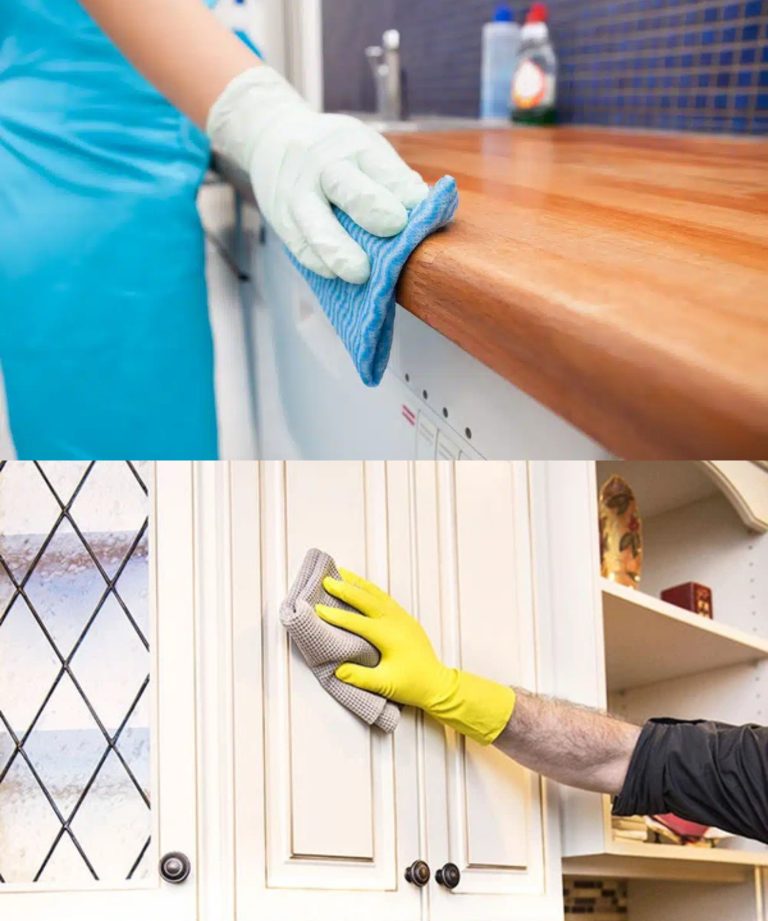ADVERTISEMENT
### Step 2: Prepare the Cleaning Solution
Start by filling a bowl or bucket with warm water. You want the water to be warm but not too hot, as extremely hot water can damage some cabinet finishes. For every gallon of warm water, add about 1 tablespoon of dish soap. Then, add 2-3 tablespoons of baking soda. Stir the solution until the baking soda dissolves and the soap is well-integrated into the water.
The combination of dish soap and baking soda will create a degreasing powerhouse that breaks down grease, dirt, and food residue on your cabinets.
### Step 3: Test an Inconspicuous Area
Before cleaning the entire surface of your cabinets, it’s always a good idea to test the solution on an inconspicuous area first. This ensures that the solution doesn’t cause any damage or discoloration to your cabinet’s finish. If everything looks good after a quick test, you can proceed to clean the rest of your cabinets.
### Step 4: Apply the Cleaning Solution
Once you’ve tested the solution, dip a soft cloth or sponge into the warm water mixture. Wring out any excess liquid, so the cloth is damp, not soaking wet. Begin wiping down the surface of your cabinets in small sections. Start at the top and work your way down to avoid dripping onto areas you’ve already cleaned.
As you wipe, you’ll notice that the grease and grime will start to dissolve. If there are areas with more stubborn grease buildup, you can apply a little extra pressure or use a soft-bristled brush to scrub away the residue.
### Step 5: Wipe Away the Grease
After allowing the cleaning solution to sit for a minute or two on the greasy areas, use the cloth or sponge to wipe away the dissolved grease. You’ll notice that the grease lifts off the cabinets easily, leaving behind a clean surface.
For areas with heavy grease buildup, repeat the process. You may need to apply a second round of cleaning solution to tackle the stubborn grime.
### Step 6: Dry the Cabinets
After wiping away the grease, use a microfiber cloth to dry your cabinets. Microfiber is particularly effective at trapping any remaining moisture, helping to prevent water spots or streaks from forming on your cabinets. Drying your cabinets also helps maintain the finish and ensures that no moisture is left behind to attract more grime.
### Step 7: Regular Maintenance
Once your cabinets are clean and grease-free, consider implementing a regular cleaning routine to keep them looking fresh. A quick wipe down with warm water and a small amount of dish soap once a week can help prevent grease from building up again. This maintenance routine will save you time in the long run and ensure that your kitchen remains in top shape.
## Additional Tips for Cleaning Kitchen Cabinets
While the dish soap and baking soda solution is highly effective for removing grease, here are a few additional tips to enhance your cleaning process:
### 1. **Use a Degreasing Spray for Heavy Grease**
If your cabinets have particularly heavy grease buildup, you can use a commercial degreaser spray before applying the dish soap and baking soda mixture. Spray the degreaser on the cabinets, let it sit for a few minutes, and then follow up with the cleaning solution to ensure that the grease is fully removed.
### 2. **Clean the Cabinet Handles Separately**
Cabinet handles and knobs often accumulate grease and fingerprints. You can clean these separately by soaking a cloth or sponge in the cleaning solution and wiping the handles. For stubborn spots, use a soft toothbrush to scrub away the grime.
### 3. **Use Olive Oil for Polishing**
After cleaning your cabinets, you can add a touch of olive oil to a clean cloth and gently rub it onto the wood to give it a natural shine. Olive oil is a great way to restore the finish of wooden cabinets and add a polished look without using harsh chemicals.
### 4. **Keep the Kitchen Ventilated**
Prevent future grease buildup by ensuring proper ventilation while cooking. Use your kitchen’s exhaust fan or open a window to reduce the amount of grease that settles on your cabinets. This can help reduce the frequency of deep cleaning.
—
## Conclusion: Effortless Cleaning Without Scrubbing
Cleaning your kitchen cabinets doesn’t have to be a tedious, scrubbing-intensive process. By adding dish soap and baking soda to warm water, you can easily remove grease and fat without scrubbing for hours. This simple, cost-effective, and eco-friendly solution helps dissolve stubborn grease and food residue, leaving your cabinets looking fresh and clean with minimal effort.
Not only does this method save you time and energy, but it also ensures that your kitchen remains a healthy and hygienic space. With just a few ingredients that you likely already have in your home, you can restore the appearance of your kitchen cabinets and make them shine like new.
By following this easy method and making it part of your regular cleaning routine, you’ll never have to worry about greasy cabinets again. Your kitchen will not only look cleaner, but it will also feel more inviting—making it a better space for cooking, entertaining, and enjoying meals with your loved ones. Happy cleaning!
